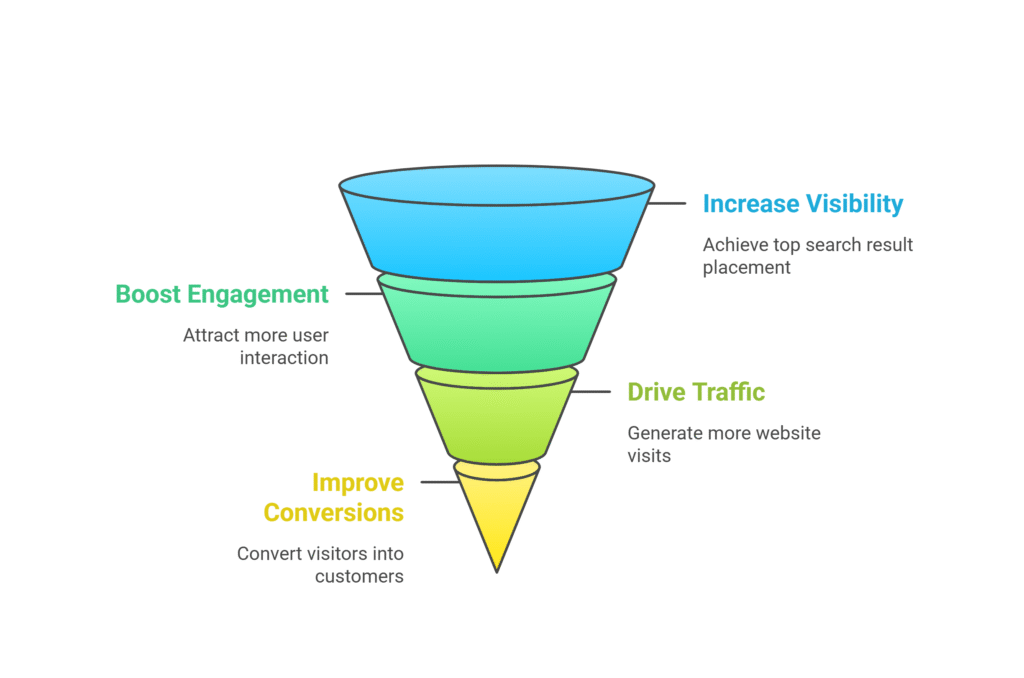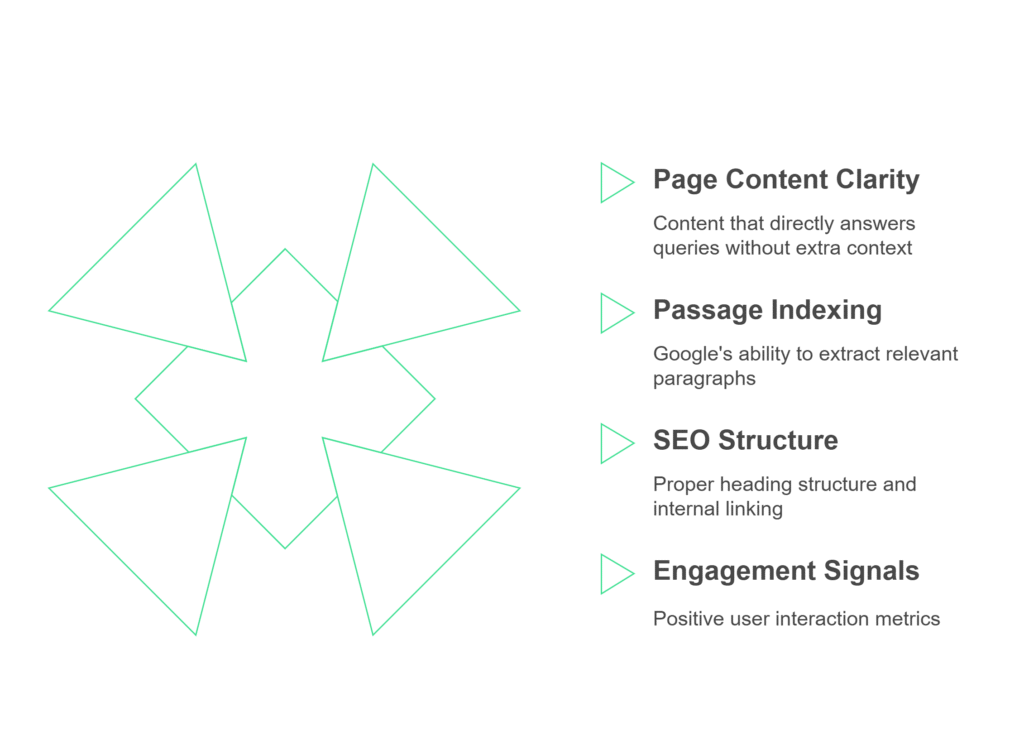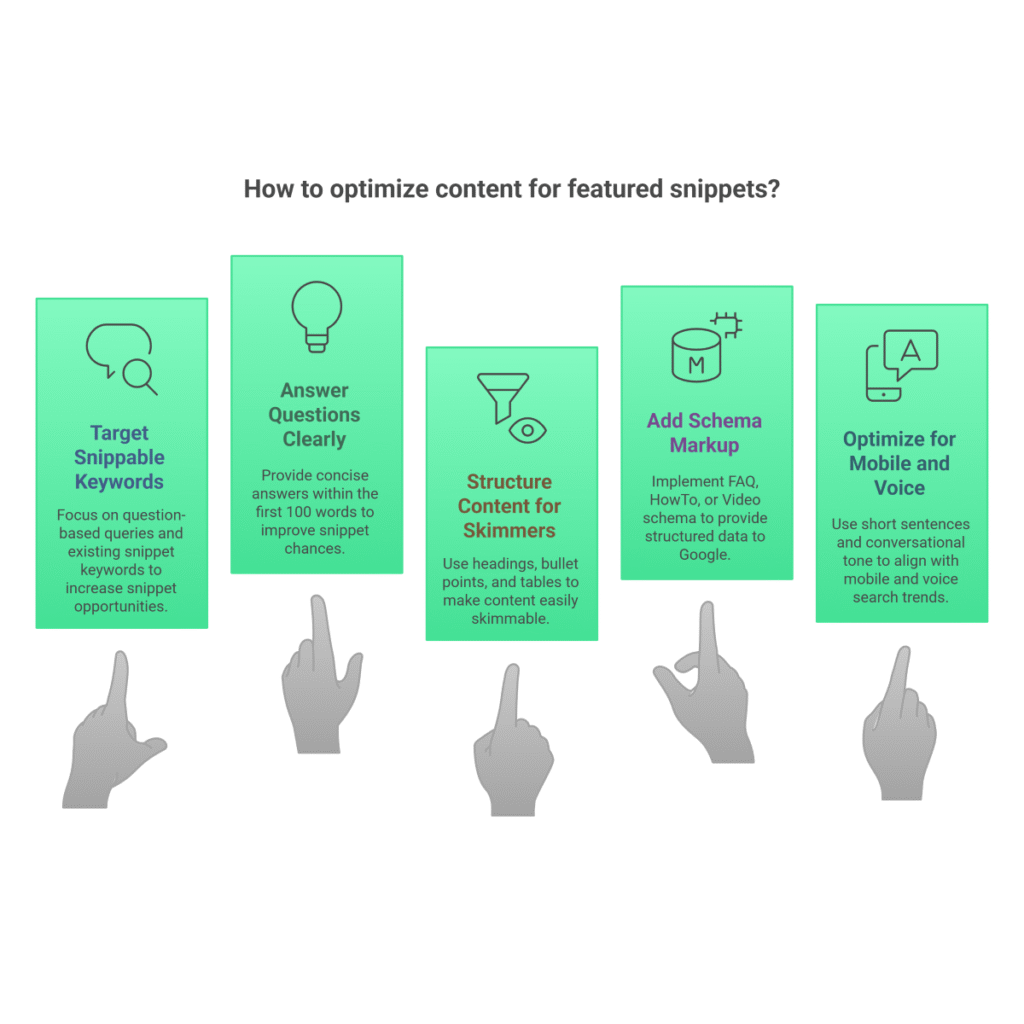Featured snippets represent the ultimate prize in search engine optimization. When your content appears in position zero, you’re not just getting visibility—you’re establishing authority, driving traffic, and stealing clicks from competitors who might technically rank higher.
This comprehensive guide reveals proven strategies to capture featured snippets and dominate search results.
What is a Featured Snippet?
A featured snippet is a short, highlighted answer that shows up at the top of Google’s search results—above regular listings. Think of it as Google’s way of saying, “This content perfectly answers what you’re looking for.”
These snippets pull content directly from web pages and display it in a special box format. What makes them so powerful is their prime real estate—they appear before the traditional number one organic result, which is why they’re often called “Position Zero.”
Featured snippets come in different formats: paragraph answers for definitions, numbered lists for how-to queries, tables for comparisons, and video snippets for visual instructions. Each format serves specific search intents and requires tailored optimization strategies.
Why Google Shows It
Google pulls content from top-ranking pages to give users quick answers without needing to click a link. This aligns with Google’s mission to organize the world’s information and make it universally accessible.
From Google’s perspective, featured snippets dramatically improve user experience. Someone searching “how many teaspoons in a tablespoon” wants an immediate answer, not a journey through multiple cooking websites. By providing instant gratification, Google keeps users satisfied and engaged with their search platform.
However, studies show that featured snippets actually increase click-through rates to source websites. Users view snippets as previews and often want deeper information, making snippets a win-win for both Google and content creators.
Why Featured Snippets Matter
Traffic Benefits

Featured snippets deliver measurable business impact through multiple channels:
- Own “Position Zero” for maximum visibility: Even if your page ranks third or fourth organically, earning the featured snippet puts your content above the traditional number one result.
- Boost click-through rates (CTR), especially for mobile and voice search: Featured snippets can increase CTR by up to 35% according to recent data. On mobile devices, where screen space is limited, this effect becomes even more pronounced as snippets dominate the visible search area.
- Improve credibility and page authority: When Google features your content, it serves as an algorithmic endorsement. This trust signal transfers to your brand, improving user perception and potentially boosting rankings for related queries.
Beyond raw traffic numbers, featured snippet traffic tends to be higher quality. Users who click through after seeing a snippet preview are already engaged with your content, leading to longer session durations and lower bounce rates.
Impact on Voice Search Results
Voice assistants often pull their answers directly from featured snippets. When someone asks Alexa or Google Assistant a question, the response frequently comes from the same content that appears in featured snippets for text searches.
Voice search queries align perfectly with featured snippet optimization because they tend to be longer, more natural, and question-based. Instead of typing “red wine stain removal,” users ask, “How do I get red wine out of my white shirt?” These natural language queries are ideal featured snippet targets.
Types of Featured Snippets
Understanding snippet formats helps you tailor content for maximum effectiveness. Google doesn’t randomly choose display formats—different query types trigger specific snippet structures.
| Format | Best For | Example Query | Optimization Tips |
|---|---|---|---|
| Paragraph | Definitions, concise answers | “What is SEO?” | Lead with clear definition in 40-60 words |
| List | How-tos, recipes, steps | “How to bake a cake” | Use numbered steps or bullet points |
| Table | Comparisons, data | “Credit card interest rates” | Structure data in HTML tables |
| Video | Tutorials, visual instructions | “How to change a tire” | Optimize YouTube descriptions and timestamps |
Paragraph snippets work best for direct questions requiring straightforward answers.
List snippets appear for process-oriented queries. Google automatically formats these from existing content, so well-structured how-to guides with clear steps perform exceptionally well.
Table snippets excel for comparison content. Even if your original content isn’t in table format, Google sometimes creates tables from organized list data, making structured comparison content valuable.
Video snippets represent the newest opportunity, pulling from YouTube videos that best answer visual queries. These snippets show specific timestamps where answers begin, making video optimization increasingly important.
How Google Picks Featured Snippets

Google’s featured snippet selection follows identifiable patterns that you can leverage:
- Page content must answer the query clearly and concisely: Google prioritizes direct answers that provide complete information without requiring additional context. Content must be comprehensive yet concise.
- Uses passage indexing to highlight parts of a page: Google can identify and extract relevant paragraphs from longer articles, meaning you don’t need dedicated pages for every snippet opportunity. Well-structured long-form content can capture multiple snippets.
- SEO structure, internal linking, and engagement signals matter: Pages earning featured snippets typically demonstrate strong overall SEO performance, including proper heading structure, strategic internal linking, and positive user engagement metrics.
Google continuously tests different snippets for the same query. You might win a featured snippet temporarily, lose it to a competitor, then regain it as Google evaluates performance. This dynamic nature requires ongoing monitoring and optimization.
Search intent alignment proves crucial. Google has become sophisticated at understanding not just what people search for, but why they’re searching. Featured snippets must match the dominant search intent for specific queries.
How the Latest Google Updates Affected Snippets (2023–2024)
Helpful Content Update
Google now favors content that prioritizes user intent over keyword manipulation. The Helpful Content Update, rolled out in multiple phases through 2023 and 2024, fundamentally changed content evaluation criteria.
For featured snippets, this means Google better identifies content written primarily for users versus content created solely for search engines. Traditional keyword stuffing tactics now actively harm snippet chances rather than help them.
The update specifically targets content that exists only to rank in search engines rather than help people. This includes answers to questions nobody asks, obviously keyword-stuffed content, or low-quality responses targeting specific queries without providing genuine value.
Snippet optimization strategy: Focus on authentically answering real user questions using natural language. Provide complete, helpful responses that satisfy user intent rather than merely targeting keywords.
Passage Indexing
Even a single paragraph buried deep in your post can now get featured—if it’s well-written and structured. Passage indexing expanded the content pool Google considers for featured snippets.
Previously, Google evaluated pages holistically. If your page focused on “digital marketing” but contained one excellent paragraph about “email open rates,” that paragraph rarely earned snippets because the overall page wasn’t specifically about email metrics.
Now Google identifies and understands individual passages within longer content. That detailed email metrics paragraph can absolutely earn a featured snippet, even within a broader digital marketing guide.
This creates opportunities for comprehensive content creators. Instead of creating separate pages for every snippet opportunity, you can build authoritative long-form content addressing multiple related questions, with each section becoming a potential snippet candidate.
How to Optimize for Featured Snippets: Step-by-Step
![]()

1. Target Snippable Keywords
Use question-based keywords and tools like Ahrefs or SEMrush to find snippet opportunities. Not all keywords trigger snippets, and not all opportunities are worth pursuing.
Start with existing snippet keywords: Identify queries that already display featured snippets using Ahrefs’ Keywords Explorer with SERP features filters. This confirms Google considers these queries snippet-worthy.
Focus on question-based queries: Keywords starting with “what,” “how,” “why,” “when,” and “where” are snippet goldmines. Don’t ignore implied questions—searches like “best noise-canceling headphones” really ask “what are the best noise-canceling headphones?”
Target low-hanging fruit: Look for keywords where you already rank on page one but don’t own the snippet. You have Google’s trust for these queries; you just need format optimization to earn the snippet.
Use tools like AnswerThePublic or Google’s “People Also Ask” feature for related questions. Optimizing for one snippet often helps earn snippets for semantically related queries.
2. Answer Questions Clearly & Early
Most content creators bury answers in lengthy introductions or assume readers need extensive background before reaching the point. This approach kills snippet chances.
- Keep answers under 50 words: Google’s featured snippets typically display 40-60 words. Longer answers get truncated, potentially becoming incomplete or confusing.
- Use plain language. No fluff: Write like you’re explaining to a friend. Avoid jargon, complex sentences, or unnecessary qualifiers. Replace “The optimal methodology for enhancing search engine optimization involves” with “To improve your SEO, you should.”
- Place answers in the first 100 words if possible: While passage indexing allows Google to find answers anywhere, early answers are more likely to be featured and improve user experience for click-through visitors.
Practical approach: After your introduction, include a direct answer paragraph that could stand alone as a complete response. Use the remaining content for context, examples, and deeper information.
For “what is content marketing” queries, start with: “Content marketing is a strategy that involves creating and sharing valuable content to attract and engage a target audience, ultimately driving profitable customer action.” Don’t begin with marketing history or general business needs.
3. Structure Your Content for Skimmers
Online readers skim rather than read word-for-word. Google understands this behavior, and featured snippets accommodate skimmable content. Your structure must serve both human readers and Google’s algorithms.
- Use H2 and H3 tags properly: Heading structure tells Google how content is organized. Use H2 tags for main sections and H3 tags for subsections. Make headings descriptive—”Pricing Information” beats “Details.”
- Implement bullet points or numbered steps for lists: When explaining processes or listing benefits, use proper HTML formatting. Google easily extracts this information for list snippets.
- Include summary tables when relevant: Comparison content benefits from table formatting, even for simple feature comparisons. Tables make content immediately snippet-friendly.
Consider content hierarchy where each section can stand alone while contributing to the overall topic. Use transition sentences to connect ideas, but ensure individual sections are self-contained for passage indexing.
White space improves readability. Break up long paragraphs, use bullet points generously, and favor shorter sentences. Easy-to-read content actually is easier to read—and easier for Google to parse.
4. Add Schema Markup
Add FAQ, HowTo, or Video schema using tools like Merkle’s Schema Generator or RankMath plugin. Schema markup provides Google with structured data about your content.
FAQ schema is particularly powerful because it directly tells Google “these are questions and answers.” Implementing FAQ schema on frequently asked questions sections significantly increases snippet chances.
HowTo schema works similarly for process-oriented content. Marking up step-by-step guides with HowTo schema makes it extremely easy for Google to understand and extract your content for snippets.
Video schema helps Google understand video content and can improve video snippet chances. Include details like duration, upload date, and descriptions.
Plugins like RankMath, Yoast, or Schema Pro simplify schema implementation without requiring coding expertise. Many tools automatically generate appropriate schema markup based on content structure.
5. Optimize for Mobile and Voice
Use short sentences, conversational tone, and mobile-friendly layout. Over half of all searches now occur on mobile devices, and voice search continues growing rapidly.
Mobile optimization considerations: Long paragraphs become intimidating text walls on small screens. Short paragraphs, bullet points, and clear headings make content much more mobile-friendly.
Voice search alignment: Voice queries tend to be longer and more conversational. Instead of typing “red wine stain removal,” users ask “How do I get red wine out of my white shirt?” These natural language queries perfectly align with featured snippet optimization.
Write conversationally using the same language your audience uses. If they say “fix,” don’t write “remediate.” If they say “cheap,” don’t write “cost-effective.” Match your audience’s vocabulary and speech patterns.
Real-Life Featured Snippet Examples by Industry
Examining successful snippets across different industries reveals optimization patterns and opportunities:
- Health: “What are symptoms of flu?” triggers list format from Mayo Clinic. Medical sites excel at snippets by providing clear, authoritative answers to common health questions. Mayo Clinic’s success comes from structured approaches: leading with common symptoms in scannable lists, leveraging medical authority for trust, and providing complete but concise information.
- Finance: “Best credit cards for cashback” generates table format comparing providers. Financial sites earn table snippets by presenting comparison data clearly. These snippets work because they directly answer “which option is best” queries with side-by-side feature, rate, and benefit comparisons.
- Ecommerce: “How to choose shoe size” displays paragraph format from online store blogs. E-commerce sites earn snippets by solving customer problems, even when those problems aren’t directly purchasing-related. Shoe sizing snippets build trust and position retailers as helpful resources, increasing shopping likelihood when users are ready to buy.
These examples share a common thread: they prioritize user value over direct promotion. Mayo Clinic doesn’t push services in their flu symptom snippet. Credit card snippets provide objective comparison data. Shoe sizing guides help people make better decisions rather than pushing specific products.
This user-first approach is essential for featured snippet success. Google wants to feature content that genuinely answers user questions, not content serving primarily business goals.
How to Track and Test Snippet Performance
Tools You Can Use
Monitoring featured snippet performance requires appropriate tools and regular attention:
- Ahrefs – Shows which snippets you currently own: Keywords Explorer includes dedicated SERP features filters showing exactly which keywords trigger featured snippets and whether you own them. You can also identify competitor snippet ownership for optimization targeting.
- SEMrush – Tracks opportunities and SERP features: Position Tracking monitors SERP features over time, revealing when you gain or lose snippets. Their Keyword Magic Tool identifies previously unconsidered snippet opportunities.
- Google Search Console – Monitor CTR and rankings: While Search Console doesn’t specifically identify featured snippets, you can often spot them by finding keywords where average position exceeds typical CTR expectations. Snippets sometimes show lower CTR than traditional number-one rankings because users get answers without clicking.
Establish regular monitoring for target keywords. Featured snippets can be volatile—winning today and losing tomorrow as Google tests different results. Regular monitoring enables quick change identification and response.
Test with Visual Tools
- Use Google’s Rich Results Test: This free Google tool shows how structured data appears to search engines and helps identify markup issues preventing snippet eligibility.
- Try Chrome extensions like Detailed SEO or SEO Pro: These extensions display SERP features directly in browsers during searches, making it easy to spot snippet opportunities during regular research.
Don’t forget manual testing. Regularly search target keywords in different locations and on different devices. Featured snippets can vary based on location, device type, and search history.
Use incognito mode for unbiased results, and consider VPN tools for testing geographic variations if you serve multiple markets.
Common Mistakes to Avoid
Even well-intentioned optimization efforts can sabotage snippet chances. Here are the most common mistakes and prevention strategies:
- Keyword stuffing instead of clear answers: Cramming target keywords into every sentence makes content harder to read and less likely to provide the clear, natural answers Google wants to feature. Focus on answering questions completely and naturally—keywords will flow from good content.
- Ignoring structure and skipping subheadings: Content without clear structure is difficult for both users and Google to understand. Wall-to-wall paragraphs without headings, bullet points, or structural elements make it much harder for Google to extract snippet-worthy passages.
- No schema markup – missing a simple boost! Schema markup isn’t always necessary for featured snippets, but it provides significant advantages, especially for FAQ and HowTo content. Since most competitors probably aren’t using schema markup, implementation creates relatively easy competitive advantages.
Another common mistake is focusing only on snippet optimization while ignoring overall user experience. Earning featured snippets is just the beginning—you want users to click through and engage with your content. Ensure your complete page delivers on snippet promises.
Avoid optimizing for snippets at the expense of overall content quality. Well-optimized pages providing genuine value will always outperform pages optimized purely for snippet capture without considering user needs.
Final Thoughts
Featured snippet optimization represents a strategic approach to becoming genuinely helpful to your audience. When you create content that clearly answers questions, provides real value, and makes information easily accessible, featured snippets become natural results rather than forced outcomes.
Remember that snippet optimization is an ongoing process, not a one-time task. Google continuously updates algorithms, user behavior evolves, and competitors constantly improve their content. Success requires vigilance, testing, and prioritizing user experience over search engine manipulation.
Start with one keyword where you already rank well, identify the current featured snippet, and optimize your content to provide a better answer. Test, measure, and iterate. With consistent application of these strategies, you’ll dominate position zero and enjoy the traffic, authority, and business benefits that follow.


